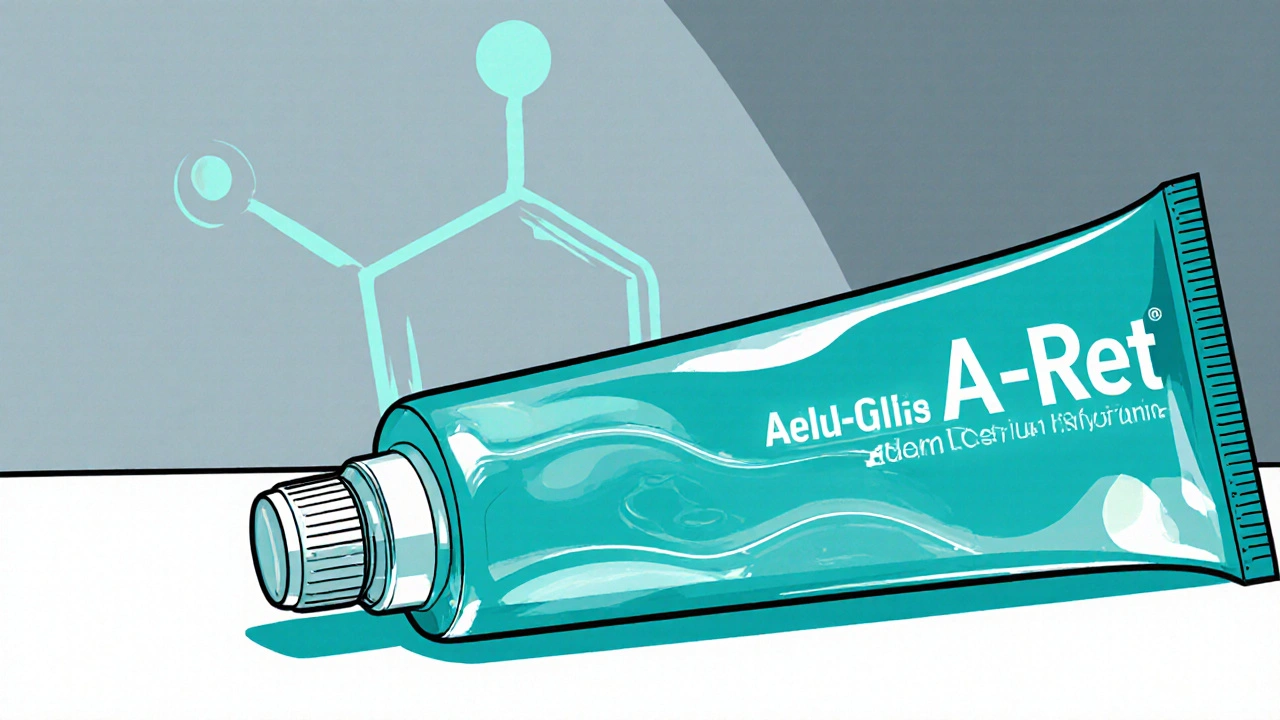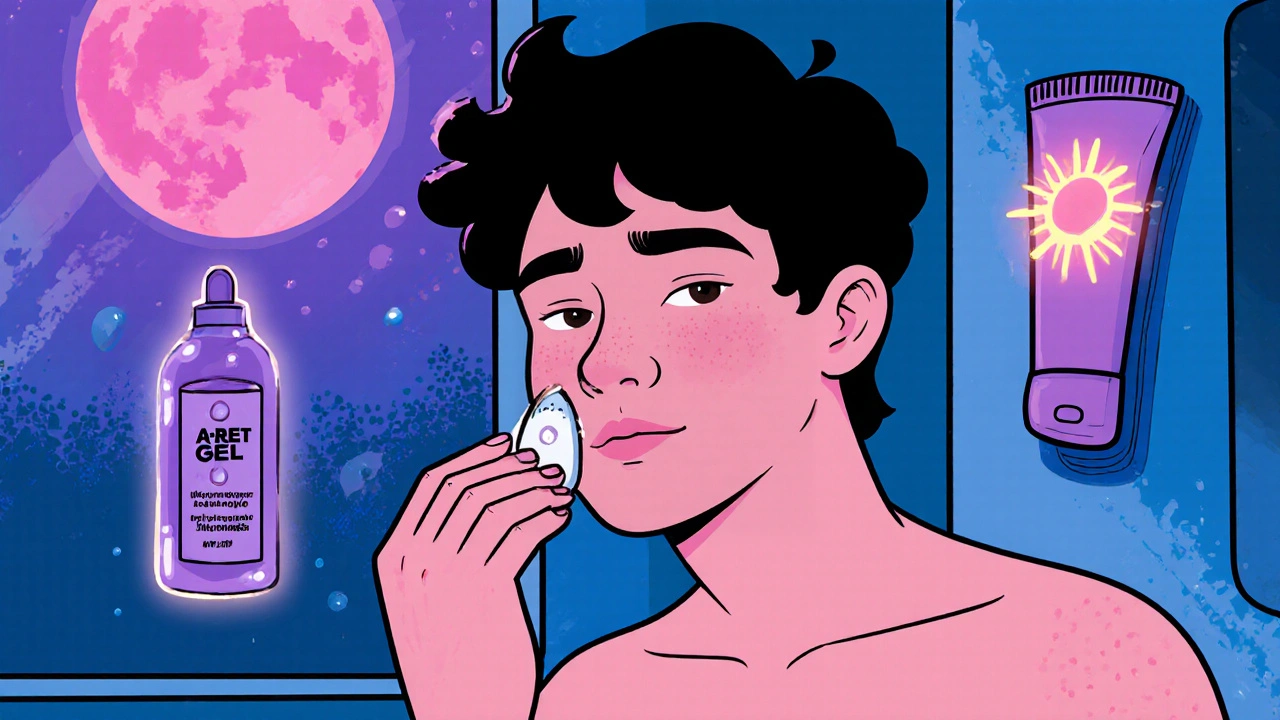 Oct, 18 2025
Oct, 18 2025
Retinoid Selection Tool
Personalized Retinoid Recommendation
Answer a few questions to find the best retinoid option for your skin type and concerns.
Your Recommendation
What to Expect
Key Takeaways
- A‑Ret Gel delivers prescription‑strength tretinoin, making it one of the most potent anti‑aging and acne treatments.
- Over‑the‑counter retinoids like Differin (adapalene) are milder but easier to start with.
- Bakuchiol offers a plant‑based option with similar collagen‑boosting effects but no irritation.
- Combination regimens (e.g., tretinoin + niacinamide) can balance effectiveness and tolerability.
- Choosing the right product depends on skin type, concerns, and how much downtime you can handle.
What is A‑Ret Gel (Tretinoin)?
When it comes to tackling acne and signs of aging, A‑Ret Gel is a prescription‑strength formulation of tretinoin, a retinoic acid derivative that accelerates cell turnover and stimulates collagen production. The gel typically comes in 0.025% or 0.05% concentrations, meaning each milligram packs a serious punch compared with over‑the‑counter retinoids.
The active ingredient, tretinoin, is the same molecule that powers the classic dermatology brand Retin‑A, but A‑Ret Gel is marketed as a more affordable, generic option. Dermatologists prescribe it for moderate to severe acne, melasma, and fine‑line reduction.
How Tretinoin Works
Tretinoin binds to retinoic acid receptors (RAR‑α, RAR‑β, RAR‑γ) inside skin cells. This triggers a cascade that:
- Speeds up the shedding of dead skin cells, preventing clogged pores.
- Boosts fibroblast activity, leading to new collagen fibers.
- Reduces the appearance of hyperpigmentation by encouraging even melanin distribution.
Popular Alternatives to A‑Ret Gel
Not everyone can handle a prescription retinoid, and some prefer non‑prescription routes. Below is a quick rundown of the most common alternatives, each introduced with microdata so search engines can recognize them.
Retin‑A is the brand‑name version of tretinoin, typically sold in cream form at 0.025%‑0.1% strengths. It shares the exact mechanism with A‑Ret Gel but often costs more.
Differin (Adapalene) is an over‑the‑counter retinoid introduced in 2016 for acne. Its concentration is 0.1% and it tends to be gentler on the barrier, making it a good starter.
Tazarotene is a third‑generation retinoid used for both psoriasis and acne. Available at 0.05%‑0.1%, it is stronger than tretinoin but often more irritating.
Bakuchiol is a plant‑derived compound from babchi seeds. It mimics retinol’s collagen‑stimulating effect without binding to retinoic acid receptors, so it rarely causes irritation.
Niacinamide is a form of vitamin B3 that improves barrier function and reduces inflammation. Used alongside retinoids, it can calm the retinoid reaction.
Vitamin C Serum is an antioxidant that brightens skin and supports collagen synthesis. When paired with tretinoin, it boosts overall anti‑aging results.
Hyaluronic Acid is a humectant that attracts water to the skin. It’s often added to retinoid routines to offset dryness.

Head‑to‑Head Comparison
| Feature | A‑Ret Gel (Tretinoin) | Retin‑A (Brand) | Differin (Adapalene) | Tazarotene | Bakuchiol |
|---|---|---|---|---|---|
| Prescription required | Yes | Yes | No | Yes | No |
| Typical concentration | 0.025‑0.05% | 0.025‑0.1% | 0.1% | 0.05‑0.1% | 0.5‑1% |
| Primary benefit | Acne & anti‑aging | Acne, fine lines | Acne, comedonal | Psoriasis, severe acne | Collagen boost, brightening |
| Typical irritation level | Moderate‑high | Moderate‑high | Low‑moderate | High | Very low |
| Cost (US, 30 days) | ~$30‑$45 | ~$80‑$120 | ~$20‑$30 | ~$70‑$100 | ~$25‑$45 |
Pros and Cons at a Glance
- A‑Ret Gel provides fast, noticeable results but demands a careful buildup phase.
- Retin‑A offers the same chemistry with a familiar brand reputation, yet it’s pricier.
- Differin is the most beginner‑friendly, though it may take longer to see anti‑aging benefits.
- Tazarotene works well for stubborn lesions but can leave the skin feeling raw.
- Bakuchiol is irritation‑free and vegan, but its effects are milder and need consistent use.
How to Choose the Right Option for Your Skin
If you’ve never used a retinoid, start with Differin or a low‑dose tretinoin cream. Patch‑test on your jawline for three nights before applying to the full face. If your skin tolerates the low dose without excessive redness, you can step up to A‑Ret Gel’s 0.025% concentration.
For experienced users who crave faster collagen turnover, the 0.05% A‑Ret Gel or Tazarotene can accelerate results, but you’ll need a robust moisturizer-think hyaluronic acid serum followed by a ceramide‑rich cream.
People with sensitive or rosacea‑prone skin often gravitate toward Bakuchiol plus niacinamide. The combo keeps the barrier happy while still delivering a gentle brightening effect.
Budget is another factor. A‑Ret Gel’s generic price is well below brand‑name Retin‑A, yet still higher than OTC options. If you’re paying out‑of‑pocket, calculate the cost per month and compare it to the expected time to see results.

Application Tips & Safety
- Cleanse with a mild, sulfate‑free cleanser. Pat skin dry; avoid rubbing.
- Apply a pea‑size amount of A‑Ret Gel to the entire face, not just blemishes. This prevents “spot‑treatment” unevenness.
- Wait 20‑30 minutes before layering other actives. This reduces the risk of pH clashes with vitamin C.
- Follow with a barrier‑repair moisturizer containing ceramides or niacinamide.
- Use sunscreen with SPF 30+ every morning. Retinoids increase photosensitivity.
- Start with every‑other‑night usage for two weeks, then assess tolerance before moving to nightly.
If you notice persistent swelling, itching, or blistering, pause use and consult a dermatologist. Those symptoms can signal an allergic reaction rather than normal irritation.
Frequently Asked Questions
Can I use A‑Ret Gel and Differin together?
Mixing two retinoids usually amplifies irritation without adding much benefit. Most experts recommend alternating nights or picking one based on your primary concern.
How long does it take to see results with A‑Ret Gel?
Most users notice reduced breakouts within 4‑6 weeks and smoother texture after 8‑12 weeks. Fine‑line improvement can take 3‑6 months of consistent use.
Is A‑Ret Gel safe during pregnancy?
Retinoids are classified as Category C and are generally avoided during pregnancy. Talk to your OB‑GYN before using any form of tretinoin.
Can I stack A‑Ret Gel with vitamin C?
Yes, but apply vitamin C in the morning and tretinoin at night. This separation prevents pH conflicts and maintains each ingredient’s stability.
What’s the best moisturizer to pair with A‑Ret Gel?
Look for a formulation with ceramides, hyaluronic acid, and peptides. Brands like CeraVe PM or La Roche‑Posay Toleriane Double Repair work well.
Bottom Line
If you can tolerate a prescription retinoid, A‑Ret Gel gives you a powerful, cost‑effective way to clear acne and smooth fine lines. For newcomers or those with sensitive skin, start with Differin or a gentle bakuchiol serum, then decide if you want to upgrade. Pair any retinoid with sunscreen, a good moisturizer, and patience-the skin transformation really shows up after a couple of months.

Rakhi Kasana
October 18, 2025 AT 23:04Prescription‑strength tretinoin is not a toy, it's a serious commitment.
When you slather on A‑Ret Gel you are basically telling your skin to reboot at warp speed.
The initial “retinoid reaction” is a red flag that your barrier is being assaulted, not a sign of failure.
If you ignore the irritation and push through, you risk chronic inflammation and post‑inflammatory hyperpigmentation.
Start with the lowest 0.025% concentration and give it at least two weeks before judging any results.
Layer a ceramide‑rich moisturizer within 30 minutes of application to seal in moisture and calm the skin barrier.
Never skip sunscreen; the increased photosensitivity can turn a mild burn into a severe flare‑up.
For acne‑prone individuals, the pore‑clearing benefits usually appear after 4‑6 weeks, but fine‑line improvements take 3‑6 months of consistent use.
Switching between A‑Ret Gel and Differin on alternate nights is a recipe for disaster – the cumulative irritation will outweigh any incremental benefit.
If you have sensitive or rosacea‑prone skin, consider a gentler starter like Differin or a bakuchiol serum before even thinking about a prescription retinoid.
Budget‑wise, A‑Ret Gel is cheaper than brand‑name Retin‑A, yet it still costs more than OTC options, so calculate the cost‑per‑month against the timeline you expect for results.
Remember, the skin remodeling process is slow; patience is the most valuable ingredient in any retinoid regimen.
Pair the gel with a vitamin C serum in the morning to boost collagen synthesis and antioxidant protection.
Avoid other strong actives like AHAs or BHA on the same night, as they will exacerbate barrier disruption.
Finally, if you ever notice persistent swelling, itching, or blistering, discontinue use immediately and consult a dermatologist – those are signs of an allergic reaction, not just a normal adjustment period.
In short, treat A‑Ret Gel with respect, provide the skin with adequate barrier support, and you’ll reap the anti‑aging and acne‑clearing rewards without the drama.
Sarah Unrath
November 11, 2025 AT 02:37i cant belive how much i spend on tretinoin its crazy
James Dean
December 4, 2025 AT 06:11thinking about retinoids feels like staring into a philosophical abyss where skin renewal meets existential dread.
the chemistry is simple yet profound the RAR receptors orchestrate a cellular symphony.
one must approach it with a calm mind and not expect overnight miracles.
consistency over hype is the true path to clarity.
embrace the slow burn and let the skin speak in its own time.